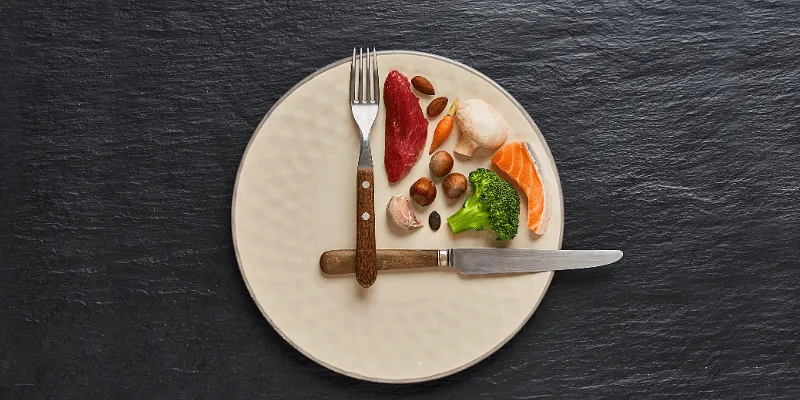Intermittent fasting: Dos and don’ts
There are several ways one can practice intermittent fasting, but it is important to know where you might be going wrong when practicing time restricted eating.
Intermittent fasting is hugely popular today! But are you practicing it the right way? The reason I wanted to bring attention to this is that recently I had several clients come to me with several health challenges. Many of them felt that they were practicing intermittent fasting.
While going through their intake and assessment, I realised that they were in fact not doing so. What were they doing that was not actually intermittent fasting? What were the other aspects that did not support their endeavor towards intermittent fasting? That’s what we are going to look at in this article.
Benefits of intermittent fasting
There are wonderful benefits to intermittent fasting, and it is very much a part of many ancient traditions, including Ayurveda.
Since you are giving periodic breaks to eating, it helps your digestive system reset itself. This break from digestion allows the gut mucosa, which is the lining of wet tissue within the digestive tract, to restore itself. When there is no digestive secretion, the tissue gets a chance to heal. The gut lining is a key area where inflammation begins, and this break can help to support overall lowering of systemic inflammation. The starvation also helps to restore balance of bacteria in the gut microbiome, as it starves the pathogenic bacteria.
The most miraculous benefit of any form of fasting is that the body uses innate intelligence to eat up old cells first. This allows you to optimise cellular function, reduce damaging free radicals, and boost energy production efficiency.
These benefits can also include relacing autoimmune cells, optimisation of hormones, reduction of insulin resistance, production of ketones for brain health, and much more.
Different ways of intermittent fasting and if you are doing it right
There are several ways to practice intermittent fasting. Let’s first take a walk through some of these and where each might be the right for you.

Image: Shutterstock
1. The most understood approach to fasting is time restricted feeding and fasting. This means that you decide on the number of hours for a fasting window which could be 14, 16, 18, or 20. Accordingly, your feeding window would then be 10, 8, 6, or 4, respectively.
2. 12-hour fasting is what most people are practicing by default, when they eat dinner at 8 and breakfast at 8.
3. One meal a day, also known as OMAD, is a 24 hour fast, where you skip eating breakfast and lunch on any day of the week, and then eat dinner. You end up fasting for 24 hours, from dinner to dinner, and this is also known as a 24 hour fast.
Since you are eating only two meals, your calorie intake is lower on that day. Practicing this two days a week, is what is known as a 5:2 fast, where you regularly eat five days of the week, and eat lower calories on two days. There are several ways that you can tweak these, but let’s look at what you might be doing wrong when practicing time restricted eating.
Mistakes to avoid
Let’s assume that you have decided to set your fasting window for 14 hours and are eating your meals within the space of 10 hours. Where does the most common mistakes occur? Having a fasting window does not mean eating frequently during the feeding window. Look at a sample meal diary of someone who was practicing intermittent fasting, but where there were too many meals during the feeding window, negating the benefits of the fasting itself.
· Two masala chai with half teaspoon milk and jaggery at 9 am
· Breakfast: of two idlis and tomato chutney at 10 am
· Coffee with jaggery at 11 am
· Lunch: roti, dal, vegetables, and buttermilk at 1pm
· Tea with some biscuits at 4pm
· Glass of wine at 6 pm
· Dinner: chicken nuggets and potato wedges at 7 pm
This meal plan has someone eating 7 mini meals throughout the feeding window, disrupting digestion, and countering the benefits of the fasting window.
To support intermittent fasting and encourage physiological benefits, you need to have three substantial meals within the feeding window, or two if you are comfortable with that. Space out your meals in a balanced manner within your feeding window.
The second mistake that is common, which you can see in this meal plan is meals that are suboptimal with plenty of different sugars sprinkled throughout the day.
One of the major benefits of fasting is reduction in insulin resistance. To support that benefit, you need to reduce sugars and optimise fibre, fats, and protein.

Fasting for several hours every day, and then eating sugars during the feeding window can disrupt blood sugar. It will only make you irritable and mentally unstable. In fact, if your fasting has made you less calm, its either not working for you or you are doing it the wrong way.
A third mistake is when people jump into fasting for 16-18 hours before optimising meals for better blood sugar balance. They will end up feeling angry, dizzy, and tired.
What is the best approach to fasting?
If you want to practice intermittent fasting, begin slowly. You can begin with even 12 hours. You need not force yourself or think that you have weak will power if you cannot fast for 16 hours while your friend can. This is not a competition. Increase it slowly, only if you are comfortable as you move further.
Your meals should have optimal protein and vegetables. If you fast for 16 hours and then eat cakes, pastries, and copious amounts of alcohol during the feeding window, it is a disservice to your body and your mind. In that case, it is better to begin by just reducing or moderating these foods, rather than having these long fasts. For example, someone fasted for three days and was so proud of himself that he celebrated by eating pizzas for the next few days!
Edited by Megha Reddy
(Disclaimer: The views and opinions expressed in this article are those of the author and do not necessarily reflect the views of YourStory.)








